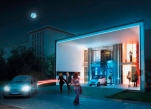Efficiency House Plus with Electromobility

In the first issue of “Green Buildings” we have started a story about energyefficient apartment building with charging for electric vehicles. The project is implemented in Berlin and is designed for operation in test mode for 2 - 3 years. In the house lives a family of four that allows a daily basis to monitor all the processes occurring in it. The house produces so much energy that it is sufficient not only to cover the needs of residents, but also for charging two electric vehicles and electric bike.
TECHNOLOGY The technical equipment is housed in the so-called “energy core”, in the glassed-in technical area. This area is an integral part of the home’s information concept. The technology is visible and comprehensible for all visitors.
The Efficiency House Plus with Electromobility utilizes the sun as its power source in two different ways: solar cell equipment generates current from the incident sunlight, while a heat pump uses the exterior air as a source for creating hot water. On an annual average, the solar cell modules on the roof and along the south face generate sufficient energy to meet all the home’s and electric vehicles’ requirements. The home as a power plant is easily comprehensible to visitors thanks to the visible solar cell surface coverage. The Efficiency House Plus has been designed for an operating life of two to three years. Geothermal power will not be utilized as the expenses involved in the subsequent removal of the ground probes are unreasonably high. Instead, a highly efficient air/water heat pump will be utilized to extract thermal energy from the outside air.
Heat requirements during the winter months will be met by an under floor heating system. The greatest possible care was also taken during the installation of the heating system, to ensure that mechanical fittings could – to the greatest possible extent – be recycled. A dry screed in the floor design provides additional storage volume in the otherwise very lightweight wood construction. Because of the heater’s low inertia, the building can quickly react to different load states in the individual rooms. Examinations in Berlin have indicated that the mean air temperature is less than 18°C for 312 days, and that heating is therefore required. However, thanks to the solar profit which the home is able to achieve, the actual number of heating days is significantly less.
No cooling will be employed in the Efficiency House Plus with Electromobility. Controllable, outdoor shading elements will prevent any overheating in the summertime. By combining the home’s technology in the energy core, wiring paths can remain short. All distribution and ventilation channels are as short as possible and, beyond this are thermally insulated, so that distribution losses can be kept at the absolute minimum.
The solar cell equipment located on the roof employs high performance, mono-crystalline modules with a high level of efficiency; these modules are particularly well suited for the conversion of direct solar radiation into electric energy. Amorphous, thin-film modules are employed in the facade; these modules are particularly well-suited for handling diffuse irradiation of the kind frequently encountered in facades. A portion of the electric current obtained from solar energy is employed to operate the air/ water heat pump, which converts energy collected from the outside air into heat for the home – and this even at low outside temperatures. The resulting thermal energy is distributed through the under floor heating and the mechanical ventilation. The employment of renewable energy in the Efficiency House Plus is highly weather-dependent.
Storage systems help better balance out supply and demand. Locally generated power is stored by a 40 kWh lithium ion battery, which comprises “secondary use” vehicle batteries. Due to their loss of storage and performance of up to 20%, these batteries are no longer suitable for employment in vehicles. Initial simulations have, however, shown that there is absolutely no reason why they cannot continue to function as stationary storage batteries for many years. The cells employed in this project have been provided by BMW (Mini E). The objective of the house battery is to serve as buffer storage in order to increase the employment of self-generated current. The current stored in the battery is available for any house-hold task, as well as to recharge the electric vehicles. Just as is the case with the charging technology, the entire household technology can be accessed by the home’s inhabitants via two touch screens as well as being able to be monitored and controlled via Smartphones.
Full version you can download here


